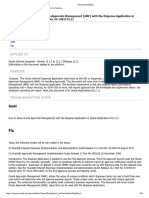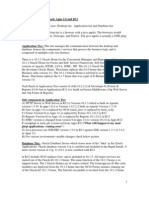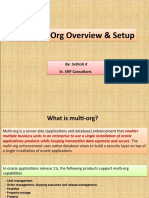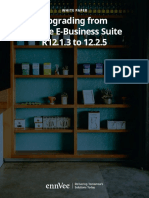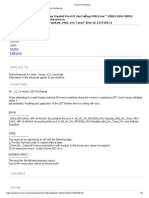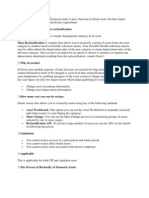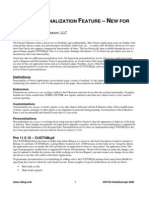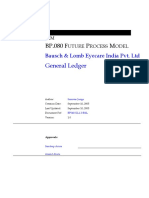Oracle EBS R12 Architecture
Oracle EBS R12 Architecture
Uploaded by
Aman DuaCopyright:
Available Formats
Oracle EBS R12 Architecture
Oracle EBS R12 Architecture
Uploaded by
Aman DuaCopyright
Available Formats
Share this document
Did you find this document useful?
Is this content inappropriate?
Copyright:
Available Formats
Oracle EBS R12 Architecture
Oracle EBS R12 Architecture
Uploaded by
Aman DuaCopyright:
Available Formats
Source http://appsdba.
info
Oracle E-Business Suite (EBS)
What is Oracle Applications/Oracle E-Business Suite ?
To facilitate big businesses, Oracle Corporation have created collection of software in the category of ERP (Enterprise Resource Planning) known as modules, that are integrated to talk to each other and known as Oracle Applications or E-Business Suite. Oracle Inventory Module deals with the items you maintain in stock, warehouse etc. Oracle Receivables and Oracle Order Management are dealing with customers like orders given by Customers and Money collected from customers. Oracle General Ledger receives information from all the different transaction modules and summarizes them in order to create profit and loss statements, reports for paying Taxes etc.
Oracle Cost Management helps to maintain the costs of items in your inventory and the immediate modules that it interacts with are Oracle Inventory, Oracle Bills of Material, Order Management.
Oracle E-Business Suite Previous Releases
10.7 : Oldest Release of Oracle ERP which is character, thin client based. Oracle has stopped support for this release from year 1998. 11 : 11i : R12 : Latest Release Of EBS by Oracle .
Source http://appsdba.info
Oracle EBS R12 Architecture
Oracle EBS R12 Applications is a three-tiered architecture. 1.Desktop Tier 2.Application Tier 3.Database Tier The Oracle Applications Architecture is a framework for multi-tiered, distributed computing that supports Oracle Applications products. In this model, various servers or services are distributed among three levels, or tiers. First we need to know the important points like SERVER, NODE, MACHINE and TIER. Server : Server is a process or group of processes that run on a single machine and provide a particular functionality. Tier : A tier is a logical group of services , that spread across more than one physical machine. Machine or node : A machine is referred to as a node, particularly in the context of a group of computers that work closely together in a cluster.
Desktop Tier :
The Forms client applet must be run within a Java Virtual Machine (JVM) on the desktop client. The Sun J2SE Plug-in component allows use of the Oracle JVM on web clients, instead of the browsers own JVM. This is implemented as a browser plug-in. Please Note : In 11i , we use Jinitiator for the for the JVM.
The Application Tier :
In Release 12, the application tier contains Oracle Application Server 10g (OAS10g). Three servers or service groups comprise the basic application tier for Oracle Applications:
Web services The Web services component of Oracle Application Server processes requests received over the network from the desktop clients.
Source http://appsdba.info
Forms services Forms services in Oracle Applications Release 12 are provided by the Forms listener servlet or Form Socket mode, which facilitates the use of firewalls, load balancing, proxies, and other networking options.
Concurrent Processing server Processes that run on the Concurrent Processing server are called concurrent requests. When you submit such a request, either through HTML-based or Forms-based Applications, a row is inserted into a database table specifying the program to be run. A concurrent manager then reads the applicable requests in the table, and starts the associated concurrent program.
Please Note: There is no concept of an Administration server in Release 12. By default, patching can be undertaken from any application tier node.
Database Tier :
The database tier contains the Oracle database server, which stores all the data maintained by Oracle Applications.
R12 EBS Directory Structure Techstack Components :
DB_TIER
10.2.0.2 RDBMS ORACLE_HOME
APPL-TIER
10.1.2 C ORACLE_HOME / FORMS ORACLE_HOME (8.0.6 ORACLE HOME as in R11i) 10.1.3 Java ORACLE_HOME/OC4J ORACLE_HOME (iAS ORACLE_HOME as in R11i) INSTANCE_TOP : Each application tier has a unique Instance Home file system associated
Source http://appsdba.info
There are two versions of Oracle Application server 10g (OAS10g) used,
The Oracle Application Server 10.1.2 ORACLE_HOME (sometimes referred to as the Tools, C, or Developer ORACLE_HOME) replaces the 8.0.6 ORACLE_HOME provided by Oracle9i Application Server 1.0.2.2.2 in Release 11i. The Oracle Application Server 10.1.3 ORACLE_HOME (sometimes referred to as the Web or Java ORACLE_HOME) replaces the 8.1.7-based ORACLE_HOME provided by Oracle9i Application Server 1.0.2.2.2 in Release 11i.
Source http://appsdba.info
(ORACLE EBS R12 ORACLE_HOMES )
Oracle EBS R12 file system has come up with new model - Code, Data, Configurations are segregated for easy maintenance, to avert NFS mount issues on shared appl tier configuration systems. Auto-config will not write anything in APPL_TOP, COMMON_TOP area in R12. All instance specific configurations, log files are written in INST_TOP area. Instance Home provides the ability to share Applications and technology stack code among multiple instances. The image shown below describes the complete directory structure for complete e-bs installation i.e. DB_TOP, APPL_TOP and new INST_TOP. If you look into the INST_TOP we will find that it only contains all the configuration files, start-stop scripts, log files, certificate files, pid files etc, so as to make DB_TOP and APPL_TOP untouched for any instance specific changes.
Source http://appsdba.info
INSTANCE TOP :
Instance home is the top-level directory for an Applications Instance which is known as Instance Home and is denoted the environment variable $INST_TOP. This contains all the config files, log files, SSL certificates etc.
Advantages of new INSTANCE HOME:
The additional Instance Home makes the middle tier easier to manage and organized since the data is kept separate from the config files. The Instance Home also has the ability to share the Applications and Technology stack code across multiple instances. Another advantage of the Instance Home is that the Autoconfig writes only in INST_TOP so APPL_TOP and ORACLE_HOME can also be made read only file system if required. To create a new instance that shares an existing middle-tier, just create a new instance_top with proper config files and NFS Mount the middle tier in the
Source http://appsdba.info
INSTANCE TOP STRUCTURE:
$INST_TOP: $APPS_BASE/inst/apps/$CONTEXT_NAME/ /admin /scripts : ADMIN_SCRIPTS_HOME: Find all AD scripts here /appl : APPL_CONFIG_HOME. For standalone envs, this is set to $APPL_TOP /fnd/12.0.0/secure : FND_SECURE: dbc files here /admin : All Env Config files here /certs : SSL Certificates go here /logs : LOG_HOME: Central log file location. All log files are placed here (except adconfig) /ora /10.1.2 servlet config files /10.1.3 and OC4J /pids /portal : ORA_CONFIG_HOME : 'C' Oracle home config, Contains tnsnames and forms listener : Apache & OC4J config home, Apache, OC4J and opmn This is the 'Java' oracle home configuration for OPMN, Apache : Apache/Forms server PID files here : Apache's DocumentRoot folder
You might also like
- OIE How To Setup Oracle Approvals Management (AME) With The Iexpense ApplicationDocument30 pagesOIE How To Setup Oracle Approvals Management (AME) With The Iexpense ApplicationMadhurima ChatterjeeNo ratings yet
- Oracle Account Generator Technical BriefDocument36 pagesOracle Account Generator Technical BrieftracejmNo ratings yet
- Oracle E-Business Suite R12 Core Development and Extension CookbookFrom EverandOracle E-Business Suite R12 Core Development and Extension CookbookNo ratings yet
- Difference Between Oracle Apps 11i and R12Document5 pagesDifference Between Oracle Apps 11i and R12Srinivasa Rao AsuruNo ratings yet
- How To Disable The 'Auto-Merge' Feature For Create Mass Additions in R12.1 Doc ID 1540186.1Document2 pagesHow To Disable The 'Auto-Merge' Feature For Create Mass Additions in R12.1 Doc ID 1540186.1عبدالرحمن فؤادNo ratings yet
- Form Personalization by A.PassiDocument11 pagesForm Personalization by A.PassiTatyana RossiNo ratings yet
- DFF SetupDocument5 pagesDFF SetupJaya KrishnaNo ratings yet
- How To Keep Journal Entry Approval HistoryDocument8 pagesHow To Keep Journal Entry Approval HistoryKriez NamuhujaNo ratings yet
- R12 Setup Check ListDocument45 pagesR12 Setup Check ListveerlasaiNo ratings yet
- TE 040 SYSTEM TEST SCRIPT Payables ImplementationDocument28 pagesTE 040 SYSTEM TEST SCRIPT Payables Implementationrobert mogakaNo ratings yet
- DFF Details StepsDocument17 pagesDFF Details StepsRAJIV MISHRANo ratings yet
- Supplier Creation r12Document15 pagesSupplier Creation r12Babu ChalamalasettiNo ratings yet
- Multi Org 11iDocument34 pagesMulti Org 11isathish40No ratings yet
- White Paper Oracle r12.2.5 Upgrade Automation Retail Ennvee11Document5 pagesWhite Paper Oracle r12.2.5 Upgrade Automation Retail Ennvee11Gopala KrishnanNo ratings yet
- How To Load A Custom Rate File in R12 EDocument32 pagesHow To Load A Custom Rate File in R12 Eorafinr12docs0% (1)
- Receipt Match AP Invoices Created Pre-GST Are Failing With ErrorDocument3 pagesReceipt Match AP Invoices Created Pre-GST Are Failing With ErrorGanesh JNo ratings yet
- GST Functional OSP Flow Phase2Document21 pagesGST Functional OSP Flow Phase2vishav_20003214No ratings yet
- Creating New Form in Oracle AppsDocument4 pagesCreating New Form in Oracle AppsSudha KrishnaNo ratings yet
- Bill Presentment Architecture 315815802.doc Effective Mm/dd/yy Page 1 of 35 Rev 1Document35 pagesBill Presentment Architecture 315815802.doc Effective Mm/dd/yy Page 1 of 35 Rev 1kashinath09No ratings yet
- How To Download Oracle E-Business Suite Extensions For Oracle Endeca, Release 12.2 V5 (Doc ID 2190279.1)Document19 pagesHow To Download Oracle E-Business Suite Extensions For Oracle Endeca, Release 12.2 V5 (Doc ID 2190279.1)Praveen Kumar100% (1)
- Oracle WF PDFDocument106 pagesOracle WF PDFSatya VissakotiNo ratings yet
- Create Event Alert in Oracle AppsDocument7 pagesCreate Event Alert in Oracle AppsLinh Dang Thi ThuyNo ratings yet
- Document Name: FSG Report Writing Guidelines Date: 10/06/2006 Author: Daniel North, ORAFINAPPS LimitedDocument28 pagesDocument Name: FSG Report Writing Guidelines Date: 10/06/2006 Author: Daniel North, ORAFINAPPS LimitedMina SamehNo ratings yet
- Why Reimplement An Eprentise White PaperDocument27 pagesWhy Reimplement An Eprentise White PaperSowjanyaPatwari0% (1)
- Classifications Asset Transfer FADocument8 pagesClassifications Asset Transfer FAyramesh77No ratings yet
- Oracle R12.1 Subledger Accounting Implementation Guide PDFDocument324 pagesOracle R12.1 Subledger Accounting Implementation Guide PDFSteffi StevenNo ratings yet
- Forms Oracle Apps R12Document53 pagesForms Oracle Apps R12Katie Ruiz100% (1)
- ID 734397.1-PO Output For Communication Concurrent Request Does Not Print Terms & ConditionsDocument1 pageID 734397.1-PO Output For Communication Concurrent Request Does Not Print Terms & ConditionsssssdevendragulveNo ratings yet
- r12 160615044117Document103 pagesr12 160615044117Katie RuizNo ratings yet
- User Roles & Management: Oracle Cloud ServiceDocument39 pagesUser Roles & Management: Oracle Cloud ServiceLenny MwangiNo ratings yet
- R12 How Do I Balance My AP Accrual Account R12 (20130415)Document31 pagesR12 How Do I Balance My AP Accrual Account R12 (20130415)Tom_Kelly_UK3815100% (1)
- ICS Connectivity Agent Concepts and Best PracticesDocument13 pagesICS Connectivity Agent Concepts and Best PracticesBarış ErgünNo ratings yet
- r12 Disable Tax Lov Ar APDocument3 pagesr12 Disable Tax Lov Ar APlucky76No ratings yet
- Forms PersonalizationDocument11 pagesForms Personalizationsiva_aspm100% (2)
- What Is Internal Sales Order?: RequisitionDocument10 pagesWhat Is Internal Sales Order?: RequisitionsajeedmujawarNo ratings yet
- Oracle Fixed AssetsDocument33 pagesOracle Fixed AssetsSuresh Chandrashekhar MishraNo ratings yet
- Data Migration R12 PDFDocument3 pagesData Migration R12 PDFram knlNo ratings yet
- Be Happy and Make Others To Be Happy - Descriptive FlexfieldsDocument17 pagesBe Happy and Make Others To Be Happy - Descriptive FlexfieldsGanapathiraju SravaniNo ratings yet
- FSG ReportsDocument4 pagesFSG ReportsIshtiaq Khan0% (1)
- Oracle Payables IssuesDocument1 pageOracle Payables IssuesSrinivasa Kirankumar100% (1)
- Oracle VM Virtual Appliance For Oracle E-Business Suite Deployment Guide, Release 12.2.10Document22 pagesOracle VM Virtual Appliance For Oracle E-Business Suite Deployment Guide, Release 12.2.10Motupalli Naga RajuNo ratings yet
- Payables Open Interface ProgramDocument3 pagesPayables Open Interface ProgramameybaraskarNo ratings yet
- Export Data From Excel To Table Using Custom Web ADI IntegratorDocument23 pagesExport Data From Excel To Table Using Custom Web ADI Integratorvedavyas4funNo ratings yet
- R12 TcaDocument10 pagesR12 TcaSaurabh SharmaNo ratings yet
- AP AR Netting OracleDocument3 pagesAP AR Netting Oracleiam_ritehereNo ratings yet
- Oracle MD.050 Sample 1Document13 pagesOracle MD.050 Sample 1asadnawazNo ratings yet
- EBS Proxy User ManagementDocument6 pagesEBS Proxy User ManagementdbaahsumonbdNo ratings yet
- General Ledger - SDD - 002Document33 pagesGeneral Ledger - SDD - 002KrishaNo ratings yet
- Supporting References in Oracle Ebs r12Document65 pagesSupporting References in Oracle Ebs r12AbbasNo ratings yet
- Overview of Position Control in Oracle HRMS (Doc ID 781997.1)Document3 pagesOverview of Position Control in Oracle HRMS (Doc ID 781997.1)obioraechezonaNo ratings yet
- Deep Drive - Customer Interface in AR - Oracle Apps EpicenterDocument38 pagesDeep Drive - Customer Interface in AR - Oracle Apps Epicenterjeetu_87No ratings yet
- Oracle Fusion Applications A Complete Guide - 2019 EditionFrom EverandOracle Fusion Applications A Complete Guide - 2019 EditionNo ratings yet
- The Business Analyst's Guide to Oracle Hyperion Interactive Reporting 11From EverandThe Business Analyst's Guide to Oracle Hyperion Interactive Reporting 11Rating: 5 out of 5 stars5/5 (1)
- Oracle SOA BPEL Process Manager 11gR1 A Hands-on TutorialFrom EverandOracle SOA BPEL Process Manager 11gR1 A Hands-on TutorialRating: 5 out of 5 stars5/5 (1)
- Oracle Business Intelligence Enterprise Edition 12c A Complete Guide - 2019 EditionFrom EverandOracle Business Intelligence Enterprise Edition 12c A Complete Guide - 2019 EditionNo ratings yet
